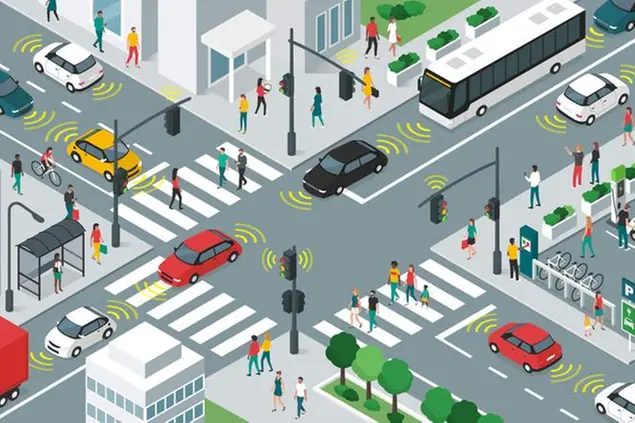PHOTO
Ras Al Khaimah, UAE: Intelligent Transportation Systems (ITS), powered by 5G and Internet of Things (IoT), are poised to take smart traffic management to the next level, creating a safer, smoother and more sustainable traffic movement in cities across the globe, according to a paper published by a group of researchers from three Middle East universities, including the American University of Ras Al Khaimah (AURAK).
The thrust of the study is the Vehicular Adhoc Networks (VANETs) – which facilitate real-time vehicle-to-vehicle and vehicle-to-infrastructure communication – using cutting-edge technology, data analytics, and communication systems, to help improve transportation networks’ effectiveness, security, and environmental friendliness, complemented by Intelligent Traffic Lights, Virtual Traffic Lights, and Mobility Prediction.
The paper quotes studies which demonstrate that ITS-based effective traffic management systems have the potential to drastically cut travel times by as much as 25%; reduce energy consumption and emissions of greenhouse gases by around 15–20 %; and reduce the number of accidents in metropolitan areas by as much as 20 %.
Prof. Stephen Wilhite, Senior Vice President of Academic Affairs and Student Success and Provost, AURAK, said: “The American University of Ras Al Khaimah is delighted to pilot this research that provides insights into how our traffic management in cities will change for the better, driven by new technologies. Some of these technologies have already been implemented in some cities, but in the near term almost all cities will adopt ITS, resulting in smoother traffic flow and reduced number of accidents.”
Prof. Maen Takruri, from the Advanced Technology and Artificial Intelligence Center, AURAK, who headed the research, said: “Smart transportation management is undergoing a revolutionary transformation, thanks to new technology. The integration of ITS within Smart City infrastructures is crucial for improving mobility, alleviating congestion, managing traffic flow, and mitigating environmental damage. Leveraging real-time communication through 5G networks and various sensor technologies -- including AI cameras and On-Board Units (OBUs), along with intelligent traffic lights -- can effectively optimize traffic flow and reduce CO2 emissions.”
The study highlights Vehicle to Vehicle (V2V) communication, in which vehicles communicate with each other directly to exchange information such as location, speed, and direction; and Vehicle to infrastructure (V2I) communication enables vehicles to communicate with traffic lights, sensors, and cameras to enhance safety and traffic flow.
In addition, there is Vehicle-to-Cloud (V2C) communication which establishes a connection between the vehicle and cloud-based services, thus enabling personalized route planning. Even more dramatic is the Vehicle-to-Pedestrian (V2P) communication which is used when a vehicle approaches an intersection or crossroad, and a pedestrian unexpectedly appears on the road without noticing the approaching vehicle.
Intelligent Traffic Lights (ITLs) help improve traffic movement and lessen congestion using real-time traffic data and sophisticated algorithms, enabling ideal scheduling for traffic lights based on variables like traffic volume, congestion, and pedestrian movement.
Another critical aspect of the study is the importance of mobility prediction which predicts vehicle movement patterns inside a network using various algorithms and data sources to accurately forecast where automobiles will be in the near future.
A number of cities have initiated investments in ITS and environmentally friendly transportation techniques as part of a vision to become Sustainable Smart Cities. The city of Los Angeles is using mobility prediction algorithms which have led to a reduction in the amount of time spent traveling. In Montreal, about half of the city’s traffic lights are now considered "intelligent" linked to a master network to enable adjustments in real time. Copenhagen has introduced a sophisticated traffic management system, making use of real-time data to monitor the flow of traffic and make adjustments to the placement of traffic lights. Seoul is installing 50,000 IoT sensors to gather information on a variety of urban phenomena.
In Dubai, the RTA has just launched Phase II of the ITS project to expand the coverage of the main road network from the current 60 percent to 100 percent by 2026. The expansion will enhance road network management and traffic flow through better monitoring, faster response times to incidents, and providing instant information to the public about the condition of the road network via new Variable Message Signs (VMS) and smart apps to help distribute traffic effectively and also cater to self-driving vehicles.
According to the paper, many automobile manufacturers are incorporating cutting-edge technology into their automobiles. They are using the technology of VANETS to stay current with the improvements that are occurring in transportation systems all around the world. Several automobile manufacturers, including Mercedes-Benz, BMW, Audi, Cadillac, Volvo, and General Motors (GM), have contributed significantly to the advancement of this field. Toyota owns the highest number of patents in V2V technology from 2010 to 2022 with 119 patents, surpassing Porsche, Ford, Hyundai, and Kia.
Other contributors to the paper were: Mohammed Al-Hattab, College of Engineering, Al Ain University; Mohamed Elassy, from the Department of Electronics and Communication Engineering, AURAK; and Sufian Badawi, Information Technology Department, Applied Science Private University, Jordan.
-Ends-
About the American University of Ras Al Khaimah
The American University of Ras Al Khaimah (AURAK), located in the United Arab Emirates, is a non-profit, public university that offers a comprehensive set of accredited and internationally recognized programs. With a focus on holistic education and practical knowledge, AURAK prepares students to become global citizens who are innovators in their respective fields. Through partnerships with top global universities and organizations, AURAK provides students unparalleled opportunities to gain international exposure and experience.
This press release is issued on behalf of the American University of Ras Al Khaimah (AURAK) by Communicate Gulf FZE, Sharjah, UAE. For media queries, please contact PR Consultant Anthony D’Silva
Email: anthony@communicategulf.net
